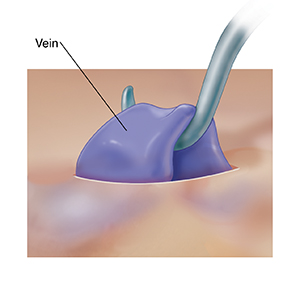If you have large varicose veins, surgery may be the best choice. But it will not prevent new varicose veins from forming. Surgery is most often done in a hospital or surgery center as an outpatient.
Varicose vein surgery
Your surgery will be tailored to your needs. Varicose veins may be tied off (ligation), destroyed, or removed. Blood will then flow through the healthy veins. One or more of the following techniques may be used:
Vein stripping and ligation
In more severe cases, where larger, deeper veins are involved, the surgeon may tie off and remove veins by making smaller cuts in the skin. Smaller branching veins may also be tied off or removed. This procedure is more painful and may need a longer recovery than other treatment options. Generally, vein stripping and ligation are advised only for people who cannot be treated with a less invasive procedure.
Microphlebectomy or ambulatory phlebectomy
A special hook is used to gently take out a varicose vein through tiny incisions. Microphlebectomy may be done in your healthcare provider’s office.

Sclerotherapy
Your healthcare provider will inject the varicose vein with a special chemical that will quickly close the vein from the inside. This is especially useful for smaller veins.
PIN stripping
All or part of the vein may be removed with a stripping tool.
Ablation (laser or radiofrequency)
A tiny cut in the skin is made near the varicose vein. A small tube called a catheter is inserted into the vein. Energy or heat released from the catheter tip will make the vein walls collapse and stick together. This stops all blood flow through the vein.